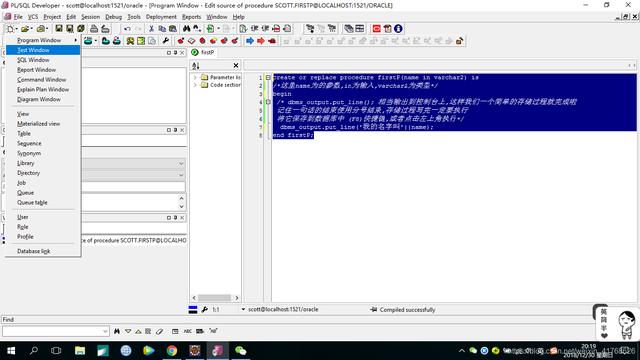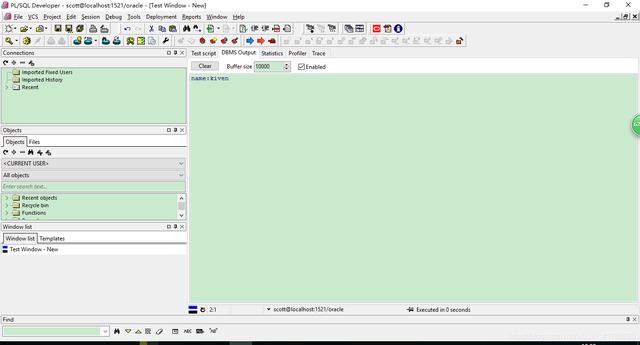创建简单存储过程(Hello World)
为了方便读者简单易懂,我将下面使用到的表复制给大家。
具体表中的数据,请大家自己填写
-- Create tablecreate table EMP( empno NUMBER(4) not null, ename VARCHAR2(10), job VARCHAR2(9), mgr NUMBER(4), hiredate DATE, sal NUMBER(7,2), comm NUMBER(7,2), deptno NUMBER(2))12345678910111213

create or replace procedure firstP(name in varchar2) is/*这里name为的参数,in为输入,varchar2为类型*/begin /* dbms_output.put_line(); 相当输出到控制台上,这样我们一个简单的存储过程就完成啦 记住一句话的结束使用分号结束,存储过程写完一定要执行 将它保存到数据库中 (F8)快捷键,或者点击左上角执行*/ dbms_output.put_line('我的名字叫'||Jackie);/*dbms_output.put_line相当于JAVA中的System.out.println("我的名字叫"+Jackie);*/end firstP;12345678下面我们要对刚刚写过的存储过程进行测试,我们开启Test Window这个窗口

-- Created on 2018/12/30 星期日 by ADMINISTRATOR declare -- Local variables here /*测试名称 名称类型 使用 := 给参数赋值,在多说一句,分号结束本句*/ name2 varchar2(64):='数据库';begin -- Test statements here firstp(name2);end;123456789我们打开DBMS Output就可以看到执行的存储过程啦。


存储过程IF判断
create or replace procedure isifp(age in number) is/*存储过程if判断以then开始,以end if; 结束*/begin if (age > 30) then dbms_output.put_line('我已经超过30岁了'); else if (age < 10) then dbms_output.put_line('我还是个儿童'); else dbms_output.put_line('我正在奋斗时期'); end if; end if;end;123456789101112131415存储过程输出
create or replace procedure inandout(name in varchar2, age in number,outp out varchar2) is/*in 代表输入,out 代表输出*/begin outp:='my name is '|| name ||',my age is '||age;/*相当于JAVA中的return outp,但是请注意,存储过程中可以return多个值*/end inandout;12345测试输出代码
-- Created on 2018/12/30 星期日 by ADMINISTRATOR declare -- Local variables here name varchar2(64):='数据库'; age number:=06; out_p varchar2(64);begin -- Test statements here inandout(name,age,outp=>:out_p); /*这里的outp是存储过程中的输出参数,out_p是在测试中使用的别名*/end;1234567891011
返回游标
create or replace procedure sysrefcursor(id in number, columnss out sys_refcursor) as/*columnss out sys_refcursor 为输出游标*/begin open columnss for select * from emp where empno=id;end;1234567测试游标
第一种测试方法
-- Created on 2018/12/30 星期日 by ADMINISTRATOR declare -- Local variables here cursor ee is select * from emp where empno=7934;begin -- Test statements here for e in ee loop dbms_output.put_line('deptno:'||e.deptno); end loop;end;12345678910输出结果如下:

第二种测试方法
-- Created on 2018/12/30 星期日 by ADMINISTRATOR declare -- Local variables here cursor ee is select * from emp where empno=7934; cur ee % rowtype;begin -- Test statements here open ee; loop fetch ee into cur; exit when ee%notfound; dbms_output.put_line('name:'||cur.ename); end loop; close ee;end;123456789101112131415
上面测试结果仅仅返回一条数据。下面我来演示返回多条数据的情况。
首先请看我表中的数据

有两个job中内容为CLERK的数据。
-- Created on 2018/12/30 星期日 by ADMINISTRATOR declare -- Local variables here cursor ee is select * from emp where job='CLERK';begin -- Test statements here for e in ee loop dbms_output.put_line('deptno:'||e.deptno); end loop;end;12345678910
游标返回多条数据。
由于对于初学者来说,游标可能不是很容易理解,下面我用JAVA语言来描述一下。
我们在java程序中写条件查询的时候,返回出来的数据是List。这个操作相当于游标,说白了就是个查询而已(大家不要误认为就这么一句简单的SQL为什么要用游标,因为只是方便读者学习游标罢了,具体业务具体分析,请不要抬杠哦)
当我们要使用list中的数据时,我们使用循环调用某一条数据时,是不是就要用实体类对象点get字段。可以理解为for e in ee loop dbms_output.put_line('deptno:'||e.deptno); end loop;
这里面的e.deptno。
获取table中的column
create or replace procedure intop(id in number, print2 out varchar2) as e_name varchar2(64);begin select ename into e_name from emp where empno = id; if e_name ='ALLEN' then dbms_output.put_line(e_name); print2:='my name is '||e_name; else if e_name ='SMITH' then print2:='打印sql'||e_name; else print2:='打印其他'; end if; end if;end intop;123456789101112131415稍微复杂一点存储过程
由于朋友这里有个需求需要用存储过程,进而更新一下博客。
首先我们先创建一张表
-- Create tablecreate table CLASSES( id NUMBER not null, name VARCHAR2(14), classesc VARCHAR2(10), seq NUMBER(5))tablespace USERS pctfree 10 initrans 1 maxtrans 255 storage ( initial 64K next 1M minextents 1 maxextents unlimited );-- Create/Recreate primary, unique and foreign key constraints alter table CLASSES add constraint PK_CLASSES primary key (ID) using index tablespace USERS pctfree 10 initrans 2 maxtrans 255 storage ( initial 64K next 1M minextents 1 maxextents unlimited );1234567891011121314151617181920212223242526272829303132333435下面我们创建一个序列
-- Create sequence create sequence SEQ_CLASSESminvalue 1maxvalue 9999999999999999999999999999start with 2increment by 1cache 20;12345678下面创建存储过程,写的乱一些,希望不要介意
create or replace procedure proclasses(Names in varchar2, classescs in varchar) as/*在我们创建存储过程的时候as其实是is*/ id number;/*设置变量名称*/ c number; seq number;begin select SEQ_CLASSES.nextval into id from dual;/*获取下一个序列,使用into赋值给id这个变量名称*/ dbms_output.put_line('classescs=' || classescs);/*打印而已*/ select count(*) into c from Classes where classesc = classescs;/*条件判断,classesc=进来的变量*/ if (c > 0) then/*当数量大于0时*/ select max(seq) + 1 into seq from Classes where classesc = classescs; dbms_output.put_line('第一个seq' || seq); else if (c = 0) then seq := 0;/*如果查询出来的数量为0的时候,我们赋值seq变量为0*/ dbms_output.put_line('c=0的时候seq' || seq); end if; end if; insert into classes (id, name, classesc, seq) values (id, names, classescs, seq); /*insert插入这个不用多说了,大家都明白;注意的是我们insert之后一定要提交。 不然数据没有持久化到数据库,这个insert没有任何意义了*/end proclasses;123456789101112131415161718192021222324252627下面我们来调用这个存储过程
-- Created on 2019/1/7 星期一 by ADMINISTRATOR declare -- Local variables here names varchar2(32):='晓明'; classescs varchar2(32):='一班';begin -- Test statements here proclasses(names,classescs);end;123456789好了,如果我写的东西读者不理解,欢迎读者指出来(我会更加完善,以便读者理解记忆)。谢谢
























 被折叠的 条评论
为什么被折叠?
被折叠的 条评论
为什么被折叠?








